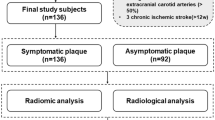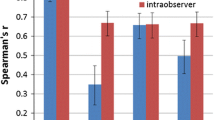Abstract
Objectives
We sought to build a high-risk plaque MRI-based model (HRPMM) using radiomics features and machine learning for differentiating symptomatic from asymptomatic carotid plaques.
Materials and methods
One hundred sixty-two patients with carotid stenosis were randomly divided into training and test cohorts. Multi-contrast MRI including time of flight (TOF), T1- and T2-weighted imaging, and contrast-enhanced imaging was done. Radiological characteristics of the carotid plaques were recorded and calculated to build a traditional model. After extracting the radiomics features on these images, we constructed HRPMM with least absolute shrinkage and selection operator algorithm in the training cohort and evaluated its performance in the test cohort. A combined model was also built using both the traditional and radiomics features. The performance of all the models in the identification of high-risk carotid plaque was compared.
Results
Intraplaque hemorrhage and lipid-rich necrotic core were independently associated with clinical symptoms and were used to build the traditional model, which achieved an area under the curve (AUC) of 0.825 versus 0.804 in the training and test cohorts. The HRPMM and the combined model achieved an AUC of 0.988 versus 0.984 and of 0.989 versus 0.986 respectively in the two cohorts. Both the radiomics model and combined model outperformed the traditional model, whereas the combined model showed no significant difference with the HRPMM.
Conclusions
Our MRI-based radiomics model can accurately distinguish symptomatic from asymptomatic carotid plaques. It is superior to the traditional model in the identification of high-risk plaques.
Key Points
• Carotid plaque multi-contrast MRI stores other valuable information to be further exploited by radiomics analysis.
• Radiomics analysis can accurately distinguish symptomatic from asymptomatic carotid plaques.
• The radiomics model is superior to the traditional model in the identification of high-risk plaques.




Similar content being viewed by others
Abbreviations
- AUC:
-
Area under the curve
- CER:
-
Contrast enhancement ratio
- GLCM:
-
Gray-level co-occurrence matrix
- GLDM:
-
Gray-level dependence matrix
- GLRLM:
-
Gray-level run-length matrix
- GLSZM:
-
Gray-level size-zone matrix
- HRPMM:
-
High-risk plaque MRI-based model
- ICC:
-
Intraclass coefficient
- IPH:
-
Intraplaque hemorrhage
- LASSO:
-
Least absolute shrinkage and selection operator
- LRNC:
-
Lipid-rich necrotic core
- MLA:
-
Minimal luminal area
- MRI:
-
Magnetic resonance imaging
- NDLR:
-
Negative diagnostic likelihood ratio
- NPV:
-
Negative predictive value
- PB:
-
Plaque burden
- PDLR:
-
Positive diagnostic likelihood ratio
- PPV:
-
Positive predictive value
- RI:
-
Remodeling index
- ROC:
-
Receiver operating characteristic
- TOF:
-
Time of flight
- VIBE:
-
Volume-interpolated breath-hold examination
References
Ooi YC, Gonzalez NR (2015) Management of extracranial carotid artery disease. Cardiol Clin 33:1–35
Naghavi M, Libby P, Falk E et al (2003) From vulnerable plaque to vulnerable patient: a call for new definitions and risk assessment strategies: part I. Circulation 108:1664–1672
Redgrave JN, Lovett JK, Gallagher PJ, Rothwell PM (2006) Histological assessment of 526 symptomatic carotid plaques in relation to the nature and timing of ischemic symptoms: the Oxford plaque study. Circulation 113:2320–2328
Zhou T, Jia S, Wang X et al (2019) Diagnostic performance of MRI for detecting intraplaque hemorrhage in the carotid arteries: a meta-analysis. Eur Radiol 29:5129–5138
Gillies RJ, Kinahan PE, Hricak H (2016) Radiomics: images are more than pictures, they are data. Radiology 278:563–577
Segal E, Sirlin CB, Ooi C et al (2007) Decoding global gene expression programs in liver cancer by noninvasive imaging. Nat Biotechnol 25:675–680
Coroller TP, Grossmann P, Hou Y et al (2015) CT-based radiomic signature predicts distant metastasis in lung adenocarcinoma. Radiother Oncol 114:345–350
Li W, Zhang L, Tian C et al (2019) Prognostic value of computed tomography radiomics features in patients with gastric cancer following curative resection. Eur Radiol 29:3079–3089
Wan L, Zhang C, Zhao Q et al (2019) Developing a prediction model based on MRI for pathological complete response after neoadjuvant chemoradiotherapy in locally advanced rectal cancer. Abdom Radiol (NY) 44:2978–2987
Kakkos SK, Stevens JM, Nicolaides AN et al (2007) Texture analysis of ultrasonic images of symptomatic carotid plaques can identify those plaques associated with ipsilateral embolic brain infarction. Eur J Vasc Endovasc Surg 33:422–429
Acharya UR, Sree SV, Mookiah MRK et al (2013) Computed tomography carotid wall plaque characterization using a combination of discrete wavelet transform and texture features: a pilot study. Proc Inst Mech Eng H 227:643–654
Shi Z, Zhu C, Degnan AJ et al (2018) Identification of high-risk plaque features in intracranial atherosclerosis: initial experience using a radiomic approach. Eur Radiol 28:3912–3921
Barnett HJM, Taylor DW, Haynes RB et al (1991) Beneficial effect of carotid endarterectomy in symptomatic patients with high-grade carotid stenosis. N Engl J Med 325:445–453
Moseley ME, Kucharczyk J, Mintorovitch J et al (1990) Diffusion-weighted MR imaging of acute stroke: correlation with T2-weighted and magnetic susceptibility-enhanced MR imaging in cats. AJNR Am J Neuroradiol 11:423–429
Azizyan A, Sanossian N, Mogensen MA, Liebeskind DS (2011) Fluid-attenuated inversion recovery vascular hyperintensities: an important imaging marker for cerebrovascular disease. AJNR Am J Neuroradiol 32:1771–1775
Takaya N, Yuan C, Chu B et al (2006) Association between carotid plaque characteristics and subsequent ischemic cerebrovascular events: a prospective assessment with MRI--initial results. Stroke 37:818–823
Zhao X, Hippe DS, Li R et al (2017) Prevalence and characteristics of carotid artery high-risk atherosclerotic plaques in Chinese patients with cerebrovascular symptoms: a Chinese atherosclerosis risk evaluation II study. J Am Heart Assoc 6:e005831
Howard DP, van Lammeren GW, Rothwell PM et al (2015) Symptomatic carotid atherosclerotic disease: correlations between plaque composition and ipsilateral stroke risk. Stroke 46:182–189
Yuan C, Kerwin WS, Ferguson MS et al (2002) Contrast-enhanced high resolution MRI for atherosclerotic carotid artery tissue characterization. J Magn Reson Imaging 15:62–67
Yu JH, Kwak HS, Chung GH, Hwang SB, Park MS, Park SH (2015) Association of intraplaque hemorrhage and acute infarction in patients with basilar artery plaque. Stroke 46:2768–2772
Qian Z, Li Y, Wang Y et al (2019) Differentiation of glioblastoma from solitary brain metastases using radiomic machine-learning classifiers. Cancer Lett 451:128–135
Zhang L, Dong D, Li H et al (2019) Development and validation of a magnetic resonance imaging-based model for the prediction of distant metastasis before initial treatment of nasopharyngeal carcinoma: a retrospective cohort study. EBioMedicine 40:327–335
Kim SM, Kim Y, Jeong K, Jeong H, Kim J (2018) Logistic LASSO regression for the diagnosis of breast cancer using clinical demographic data and the BI-RADS lexicon for ultrasonography. Ultrasonography 37:36–42
Xie H, Ma S, Wang X, Zhang X (2020) Noncontrast computer tomography-based radiomics model for predicting intracerebral hemorrhage expansion: preliminary findings and comparison with conventional radiological model. Eur Radiol 30:87–98
Fluss R, Faraggi D, Reiser B (2005) Estimation of the Youden index and its associated cutoff point. Biom J 47:458–472
Huang X, Zhang Y, Qian M et al (2016) Classification of carotid plaque echogenicity by combining texture features and morphologic characteristics. J Ultrasound Med 35:2253–2261
Funding
The authors state that this work has not received any funding.
Author information
Authors and Affiliations
Corresponding author
Ethics declarations
Guarantor
The scientific guarantor of this publication is Jiang Lin.
Conflict of interest
The authors of this manuscript declare no relationships with any companies whose products or services may be related to the subject matter of the article.
Statistics and biometry
Zhang Qingwei and Zhang Ranying did statistical analysis.
Informed consent
Written informed consent was obtained from all subjects (patients) in this study.
Ethical approval
Institutional Review Board approval was obtained.
Methodology
• Retrospective
• Diagnostic or prognostic study
• Performed at one institution
Additional information
Publisher’s note
Springer Nature remains neutral with regard to jurisdictional claims in published maps and institutional affiliations.
Electronic supplementary material
LASSO algorithm was applied, 33 features were finally retained and used to build HRPMM (details in Appendix).
The ICCs for measuring the radiological and radiomics features ranged from 0.705 to 0.951 and were summarized in the Appendix.
In the 33 final features, only sphericity, i.e. a shape feature, appeared in the four sequences’ final screening results (see Appendix).
ESM 1
(DOCX 21 kb)
Rights and permissions
About this article
Cite this article
Zhang, R., Zhang, Q., Ji, A. et al. Identification of high-risk carotid plaque with MRI-based radiomics and machine learning. Eur Radiol 31, 3116–3126 (2021). https://doi.org/10.1007/s00330-020-07361-z
Received:
Revised:
Accepted:
Published:
Issue Date:
DOI: https://doi.org/10.1007/s00330-020-07361-z




